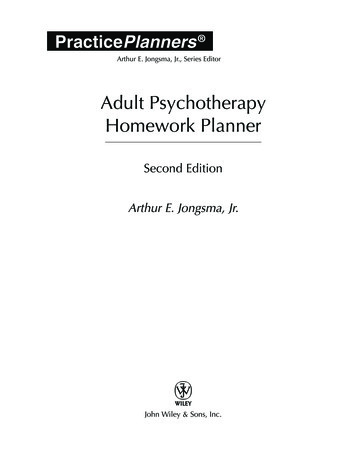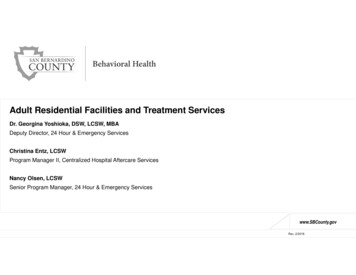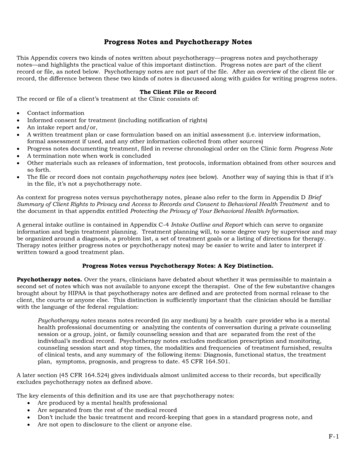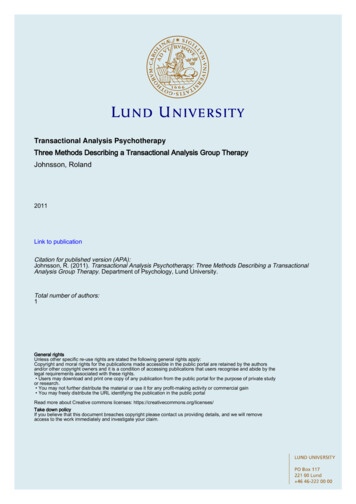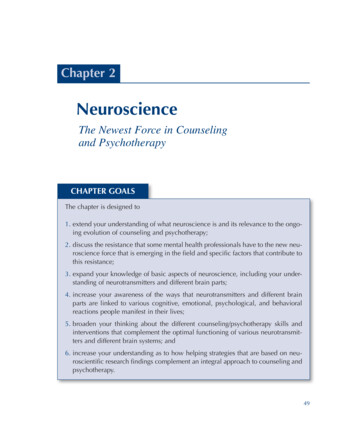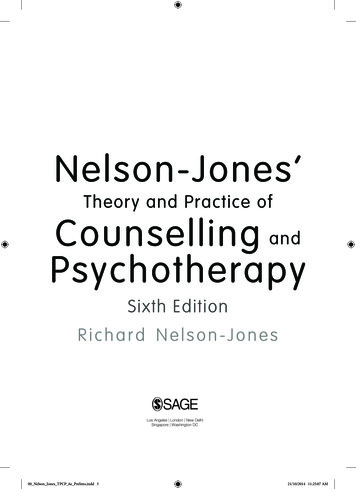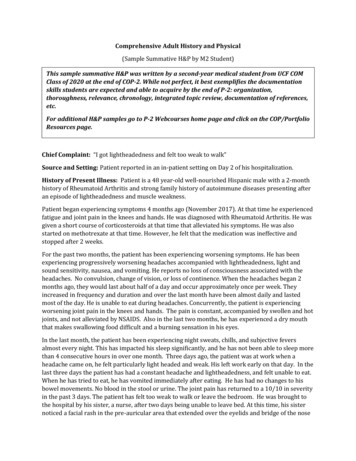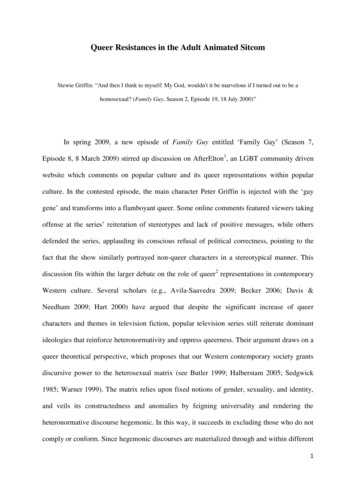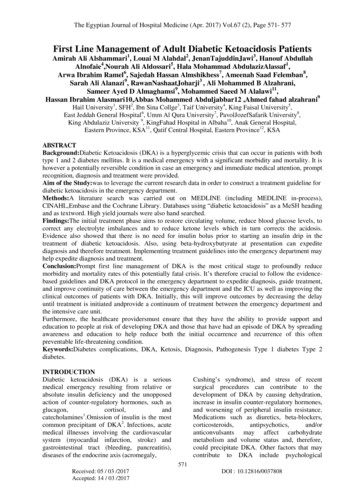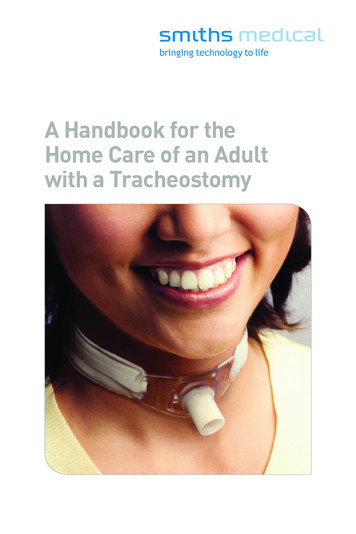
Transcription
The Complete AdultPsychotherapy TreatmentPlanner,Fifth Edition
PracticePlanners SeriesTreatment PlannersThe Complete Adult Psychotherapy Treatment Planner, Fifth EditionThe Child Psychotherapy Treatment Planner, Fifth EditionThe Adolescent Psychotherapy Treatment Planner, Fifth EditionThe Addiction Treatment Planner, Fifth EditionThe Continuum of Care Treatment PlannerThe Couples Psychotherapy Treatment Planner, Second EditionThe Employee Assistance Treatment PlannerThe Pastoral Counseling Treatment PlannerThe Older Adult Psychotherapy Treatment Planner, Second EditionThe Behavioral Medicine Treatment PlannerThe Group Therapy Treatment PlannerThe Gay and Lesbian Psychotherapy Treatment PlannerThe Family Therapy Treatment Planner, Second EditionThe Severe and Persistent Mental Illness Treatment Planner, Second EditionThe Mental Retardation and Developmental Disability Treatment PlannerThe Social Work and Human Services Treatment PlannerThe Crisis Counseling and Traumatic Events Treatment Planner, Second EditionThe Personality Disorders Treatment PlannerThe Rehabilitation Psychology Treatment PlannerThe Special Education Treatment PlannerThe Juvenile Justice and Residential Care Treatment PlannerThe School Counseling and School Social Work Treatment Planner, Second EditionThe Sexual Abuse Victim and Sexual Offender Treatment PlannerThe Probation and Parole Treatment PlannerThe Psychopharmacology Treatment PlannerThe Speech-Language Pathology Treatment PlannerThe Suicide and Homicide Treatment PlannerThe College Student Counseling Treatment PlannerThe Parenting Skills Treatment PlannerThe Early Childhood Intervention Treatment PlannerThe Co-Occurring Disorders Treatment PlannerThe Complete Women’s Psychotherapy Treatment PlannerThe Veterans and Active Duty Military Psychotherapy Treatment PlannerProgress Notes PlannersThe Child Psychotherapy Progress Notes Planner, Fifth EditionThe Adolescent Psychotherapy Progress Notes Planner, Fifth EditionThe Adult Psychotherapy Progress Notes Planner, Fifth EditionThe Addiction Progress Notes Planner, Fifth EditionThe Severe and Persistent Mental Illness Progress Notes Planner, Second EditionThe Couples Psychotherapy Progress Notes Planner, Second EditionThe Family Therapy Progress Notes Planner, Second EditionThe Veterans and Active Duty Military Psychotherapy Progress Notes PlannerHomework PlannersCouples Therapy Homework Planner, Second EditionFamily Therapy Homework Planner, Second EditionGrief Counseling Homework PlannerGroup Therapy Homework PlannerDivorce Counseling Homework PlannerSchool Counseling and School Social Work Homework Planner, Second EditionChild Therapy Activity and Homework PlannerAddiction Treatment Homework Planner, Fifth EditionAdolescent Psychotherapy Homework Planner, Fifth EditionAdult Psychotherapy Homework Planner, Fifth EditionChild Psychotherapy Homework Planner, Fifth EditionParenting Skills Homework PlannerVeterans and Active Duty Military Psychotherapy Homework PlannerClient Education Handout PlannersAdult Client Education Handout PlannerChild and Adolescent Client Education Handout PlannerCouples and Family Client Education Handout PlannerComplete PlannersThe Complete Depression Treatment and Homework PlannerThe Complete Anxiety Treatment and Homework Planner
PracticePlanners Arthur E. Jongsma, Jr., Series EditorThe Complete AdultPsychotherapyTreatment Planner,Fifth EditionArthur E. Jongsma, Jr.L. Mark PetersonTimothy J. Bruce
Cover image: Ryan McVay/Getty ImagesCover design: WileyThis book is printed on acid-free paper.Copyright 2014 by Arthur E. Jongsma, Jr., L. Mark Peterson, and Timothy J. Bruce. All rightsreserved.Published by John Wiley & Sons, Inc., Hoboken, New JerseyPublished simultaneously in CanadaNo part of this publication may be reproduced, stored in a retrieval system, or transmitted in any form orby any means, electronic, mechanical, photocopying, recording, scanning, or otherwise, except aspermitted under Section 107 or 108 of the 1976 United States Copyright Act, without either the priorwritten permission of the Publisher, or authorization through payment of the appropriate per-copy fee tothe Copyright Clearance Center, 222 Rosewood Drive, Danvers, MA 01923, (978) 750-8400, fax (978)646-8600, or on the web at www.copyright.com. Requests to the Publisher for permission should beaddressed to the Permissions Department, John Wiley & Sons, Inc., 111 River Street, Hoboken, NJ07030, (201) 748-6011, fax (201) 748-6008, or online at www.wiley.com/go/permissions.Limit of Liability/Disclaimer of Warranty: While the publisher and author have used their best efforts inpreparing this book, they make no representations or warranties with the respect to the accuracy orcompleteness of the contents of this book and specifically disclaim any implied warranties ofmerchantability or fitness for a particular purpose. No warranty may be created or extended by salesrepresentatives or written sales materials. The advice and strategies contained herein may not be suitablefor your situation. You should consult with a professional where appropriate. Neither the publisher northe author shall be liable for damages arising herefrom.For general information about our other products and services, please contact our Customer CareDepartment within the United States at (800) 762-2974, outside the United States at (317) 572-3993 or fax(317) 572-4002.Wiley publishes in a variety of print and electronic formats and by print-on-demand. Some materialincluded with standard print versions of this book may not be included in e-books or in print-on-demand.If this book refers to media such as a CD or DVD that is not included in the version you purchased, youmay download this material at http://booksupport.wiley.com. For more information about Wileyproducts, visit www.wiley.com.Library of Congress Cataloging-in-Publication Data:Jongsma, Arthur E., Jr., 1943–The complete adult psychotherapy treatment planner / Arthur E. Jongsma, Jr., L. Mark Peterson,Timothy J. Bruce.—Fifth edition.pages cm.—(PracticePlanners series)Includes bibliographical references.ISBN 978-1-118-06786-4 (pbk.)ISBN 978-1-118-41883-3 (ebk.)ISBN 978-1-118-41602-0 (ebk.)1. Psychotherapy—Planning—Handbooks, manuals, etc. 2. Psychiatric records—Handbooks, manuals,etc. I. Peterson, L. Mark. II. Bruce, Timothy J. III. Title.RC480.5.J664 2014616.89'14—dc232013030810Printed in the United States of America10 9 8 7 6 5 4 3 2 1
We dedicate this book to our most influential teachers and mentors early inour professional journey:Dr. Solomon E. FeldmanDr. Richard A. WestmaasDr. Richard BrownDr. Jack CarrDr. David H. BarlowDr. James Mancuso
CONTENTSPracticePlanners Series PrefaceAcknowledgmentsIntroductionSample Treatment Planxixiii110Anger Control ProblemsAntisocial BehaviorAnxietyAttention Deficit Disorder (ADD)—AdultBipolar Disorder—DepressionBipolar Disorder—ManiaBorderline Personality DisorderChildhood TraumaChronic PainCognitive DeficitsDependencyDissociationEating Disorders and ObesityEducational DeficitsFamily ConflictFemale Sexual DysfunctionFinancial StressGrief/Loss UnresolvedImpulse Control DisorderIntimate Relationship ConflictsLegal ConflictsLow Self-EsteemMale Sexual DysfunctionMedical IssuesObsessive-Compulsive Disorder (OCD)Panic/AgoraphobiaParanoid IdeationParentingPhase of Life 2200209220231238246257268278289296309ix
xCONTENTSPhobiaPosttraumatic Stress Disorder (PTSD)PsychoticismSexual Abuse VictimSexual Identity ConfusionSleep DisturbanceSocial AnxietySomatizationSpiritual ConfusionSubstance UseSuicidal IdeationType A BehaviorUnipolar DepressionVocational pendix A Bibliotherapy SuggestionsAppendix B References to Empirical Support and ClinicalResources for Evidence-Based ChaptersAppendix C Recovery Model Objectives and InterventionsAppendix D Alphabetical Index of Sources for AssessmentInstruments and Clinical Interview Forms Cited in Interventions472504570577
PRACTICEPLANNERS SERIES PREFACEAccountability is an important dimension of the practice of psychotherapy.Treatment programs, public agencies, clinics, and practitioners must justifyand document their treatment plans to outside review entities in order to bereimbursed for services. The books and software in the PracticePlanners series are designed to help practitioners fulfill these documentationrequirements efficiently and professionally.The PracticePlanners series includes a wide array of treatment planningbooks including not only the original Complete Adult PsychotherapyTreatment Planner, Child Psychotherapy Treatment Planner, and AdolescentPsychotherapy Treatment Planner, all now in their fifth editions, but alsoTreatment Planners targeted to specialty areas of practice, including: AddictionsCo-occurring disordersBehavioral medicineCollege studentsCouples therapyCrisis counselingEarly childhood educationEmployee assistanceFamily therapyGays and lesbiansGroup therapyJuvenile justice and residential careMental retardation and developmental disabilityNeuropsychologyOlder adultsParenting skillsPastoral counselingPersonality disordersProbation and parolePsychopharmacologyRehabilitation psychologySchool counseling and school social workSevere and persistent mental illnessSexual abuse victims and offendersSocial work and human servicesxi
xii PRACTICEPLANNERS SERIES PREFACESpecial educationSpeech-Language pathologySuicide and homicide risk assessmentVeterans and active military dutyWomen’s issuesIn addition, there are three branches of companion books that can be used inconjunction with the Treatment Planners, or on their own: Progress Notes Planners provide a menu of progress statements thatelaborate on the client’s symptom presentation and the provider’stherapeutic intervention. Each Progress Notes Planner statement isdirectly integrated with the behavioral definitions and therapeuticinterventions from its companion Treatment Planner.Homework Planners include homework assignments designed aroundeach presenting problem (such as anxiety, depression, substance use,anger control problems, eating disorders, or panic disorder) that is thefocus of a chapter in its corresponding Treatment Planner.Client Education Handout Planners provide brochures and handouts tohelp educate and inform clients on presenting problems and mentalhealth issues, as well as life skills techniques. The handouts are includedon CD-ROMs for easy printing from your computer and are ideal foruse in waiting rooms, at presentations, as newsletters, or as informationfor clients struggling with mental illness issues. The topics covered bythese handouts correspond to the presenting problems in the TreatmentPlanners.The series also includes adjunctive books, such as The Psychotherapy Documentation Primer and The Clinical Documentation Sourcebook, contain formsand resources to aid the clinician in mental health practice management.The goal of our series is to provide practitioners with the resources theyneed in order to provide high-quality care in the era of accountability. Toput it simply: We seek to help you spend more time on patients, and less timeon paperwork.ARTHUR E. JONGSMA, JR.Grand Rapids, Michigan
ACKNOWLEDGMENTSSince 2005 we have turned to research evidence to inform the treatmentObjectives and Interventions in our latest editions of the PsychotherapyTreatment Planner books. While much of the content of our Planners was“best practice” and also from the mainstream of sound psychologicalprocedure, we have benefited significantly from a thorough review thatlooked through the lens of evidence-based practice. The later editions of thePlanners now stand as content not just based on “best practice” but based onreliable research results. Although several of my coauthors have contributedto this recertification of our content, Timothy J. Bruce has been the mainguiding force behind this effort. I am very proud of the highly professionalcontent provided by so many coauthors who are leaders in their respectivesubspecialties in the field of psychology such as addiction, family therapy,couples therapy, personality disorder treatment, group treatment, women’sissues, military personnel treatment, older adult treatment, and many others.Added to this expertise over the past 7 years has been the contribution of Dr.Tim Bruce who has used his depth of knowledge regarding evidencesupported treatment to shape and inform the content of the last two editionsof Adult, Adolescent, Child, and Addiction Psychotherapy Treatment Planners.I welcome Tim aboard as an author for these books and consider it an honorto have him as a friend, colleague, and coauthor.I must also add my acknowledgment of the supportive professionalismof the Wiley staff, especially that of my editor, Marquita Flemming. Wileyhas been a trusted partner in this series for almost 20 years now and I amblessed to be published by such a highly respected company. Thank you toall my friends at Wiley!And then there is our manuscript manager, Sue Rhoda, who knows justwhat to do to make a document presentable right up to the standardsrequired by a publisher. Thank you, Sue.xiii
xivACKNOWLEDGMENTSFinally, I tip my hat to my coauthor, Mark Peterson, who launched thisAdult Psychotherapy Treatment Planner with his original content contributionsmany years ago and has supported all the efforts to keep it fresh and evidencebased.AEJI am fortunate to have been invited some seven years ago by Dr. ArtJongsma to work with him on his well-known and highly regardedPsychotherapy Treatment Planner series and now to be welcomed as one ofhis coauthors on this Planner along with Mark Peterson. As readers know,Art’s treatment planners are highly regarded as works of enormous value topracticing clinicians as well as terrific educational tools for “students” of ourprofession. That Art’s brainchild would have this type of value to our field isno surprise when you work with him. He is the consummate psychologist,with enormous breadth and depth of experience, a profound intellect, and aRogerian capacity for empathy and understanding—all of which he wouldmodestly deny. When you work with Art you not only get to know him, youget to know his family, colleagues, and friends. In doing so, you get to knowhis values. If you are like me, you have relationships that you prize becausethey are with people whom you know to be, simply stated, good. Well, to usean expression I grew up with, Art is good people. And it is my honor to havehim as a friend, colleague, and coauthor. Thank you, Art!I also would like thank Marquita Flemming and the staff at Wiley &Sons for their immeasurable support, guidance, and professionalism. It isjust my opinion, but I think Marquita should publish her own book onauthor relations.I would also like to extend a big thank-you to our manuscript manager,Sue Rhoda, for her exacting work and (needed) patience. In fact, I am sureSue will take it in stride when we ask to do one more edit of thisacknowledgment section after it has been “finalized.”Lastly, I would like thank my wife, Lori, and our children, Logan andMadeline, for all they do. They’re good people, too.TJB
The Complete AdultPsychotherapy TreatmentPlanner,Fifth Edition
INTRODUCTIONABOUT PRACTICE PLANNERS TREATMENTPLANNERSPressure from third-party payors, accrediting agencies, and other outsideparties has increased the need for clinicians to quickly produce effective,high-quality treatment plans. Treatment Planners provide all the elementsnecessary to quickly and easily develop formal treatment plans that satisfythe needs of most third-party payors and state and federal review agencies.Each Treatment Planner: Saves you hours of time-consuming paperwork.Offers the freedom to develop customized treatment plans.Includes over 1,000 clear statements describing the behavioral manifestations of each relational problem, and includes long-term goals, shortterm objectives, and clinically tested treatment options.Has an easy-to-use reference format that helps locate treatment plancomponents by behavioral problem.As with the rest of the books in the PracticePlanners series, our aim isto clarify, simplify, and accelerate the treatment planning process so youspend less time on paperwork and more time with your clients.ABOUT THIS FIFTH EDITION COMPLETE ADULTPSYCHOTHERAPY TREATMENT PLANNERThis fifth edition of the Complete Adult Psychotherapy Treatment Plannerhas been improved in many ways: Updated with new and revised evidence-based Objectives andInterventionsRevised, expanded, and updated Appendix B: Professional References1
2 THE COMPLETE ADULT PSYCHOTHERAPY TREATMENT PLANNER Many more suggested homework assignments integrated into theInterventionsExtensively expanded and updated self-help book list in Appendix A:Bibliotherapy SuggestionsAppendix C: New Recovery Model listing Goals, Objectives, andInterventions allowing the integration of a recovery model orientationinto treatment plansAddition of a chapter on Bipolar Disorder—Depression (former chapteron Depression has been renamed Unipolar Depression and Mania/Hypomania has been renamed Bipolar Disorder—Mania)Complete revision of the Cognitive Deficits chapterIntegrated DSM-5 diagnostic labels and ICD-10-CM codes into theDiagnostic Suggestions section of each chapterAdded Appendix D which provides an alphabetical index of the sourcesfor assessment instruments and clinical interview forms cited ininterventionsEvidence-based practice (EBP) is steadily becoming the standard of care inmental healthcare as it has in medical healthcare. Professional organizationssuch as the American Psychological Association, National Association ofSocial Workers, and the American Psychiatric Association, as well asconsumer organizations such the National Alliance for the Mentally Ill(NAMI) have endorsed the use of EBP. In some practice settings, EBP isbecoming mandated. It is clear that the call for evidence and accountabilityis being increasingly sounded. So, what is EBP and how is its use facilitatedby this Planner?Borrowing from the Institute of Medicine’s definition (Institute ofMedicine, 2001), the American Psychological Association (APA) has definedEBP as, “the integration of the best available research with clinical expertisein the context of patient characteristics, culture, and preferences” (APAPresidential Task Force on Evidence-Based Practice, 2006). Consistent withthis definition, we have identified those psychological treatments with thebest available supporting evidence, added Objectives and Interventionsconsistent with them in the pertinent chapters, and identified these with thissymbol: . As most practitioners know, research has shown that althoughthese treatment methods have demonstrated efficacy (e.g., Nathan &Gorman, 2007), the individual psychologist (e.g., Wampold, 2001), thetreatment relationship (e.g., Norcross, 2002), and the patient (e.g., Bohart &Tallman, 1999) are also vital contributors to the success of psychotherapy.As noted by the APA, “Comprehensive evidence-based practice will considerall of these determinants and their optimal combinations” (APA, 2006,p. 275). For more information and instruction on constructing evidencebased psychotherapy treatment plans, see our DVD-based training seriesentitled Evidence-based Psychotherapy Treatment Planning (Jongsma &Bruce, 2010–2012).
INTRODUCTION 3The sources listed in Appendix B: Professional References and used toidentify the evidence-based treatments integrated into this Planner are many.They include supportive studies from the psychotherapy outcome literature,current expert individual, group, and organizational reviews, as well asevidence-based practice guideline recommendations. Examples of specificsources used include the Cochrane Collaboration reviews, the work of theSociety of Clinical Psychology (Division 12 of the American PsychologicalAssociation) identifying research-supported psychological treatments,evidence-based treatment reviews such as those in Nathan and Gorman’s AGuide to Treatments That Work and the Substance Abuse and Mental HealthServices Administration’s (SAMHSA) National Registry of Evidence-BasedPrograms and Practices [NREPP], as well as evidence-based practiceguidelines from professional organizations such as the American PsychiatricAssociation, the National Institute for Health and Clinical Excellence inGreat Britain, the National Institute on Drug Abuse (NIDA), and theAgency for Healthcare Research and Quality (AHRQ) to name a few.Although each of these sources uses its own criteria for judging levels ofempirical support for any given treatment, we favored those that use morerigorous criteria typically requiring demonstration of efficacy throughrandomized controlled trials or clinical replication series, good experimentaldesign, and independent replication. Our approach was to evaluate thesevarious sources and include those treatments supported by the highest levelof evidence and for which there was consensus in conclusions andrecommendations. For any chapter in which EBP is identified, references tothe sources used are listed in Appendix B: Professional References and canbe consulted by those interested for further information regarding criteriaand conclusions. In addition to these references, this appendix also includesreferences to Clinical Resources. Clinical Resources are books, manuals, andother resources for clinicians that describe the details of the application or“how to” of the treatment approaches described in a chapter.There is debate regarding evidence-based practice among mental healthprofessionals who are not always in agreement regarding the best treatment orhow to weigh the factors that contribute to good outcomes. Some practitionersare skeptical about changing their practice on the basis of research evidence,and their reluctance is fueled by the methodological challenges and problemsinherent in psychotherapy research. Our intent in this book is to accommodatethese differences by providing a range of treatment plan options, somesupported by the evidence-based value of “best available research” (APA,2006), others reflecting common clinical practices of experienced clinicians, andstill others representing emerging approaches so the user can construct whatthey believe to be the best plan for their particular client.Each of the chapters in this edition has also been reviewed with the goalof integrating homework exercise options into the Interventions. Many(but not all) of the client homework exercise suggestions were taken fromand can be found in the Adult Psychotherapy Homework Planner (Jongsma,
4 THE COMPLETE ADULT PSYCHOTHERAPY TREATMENT PLANNER2014). You will find many more homework assignments suggested in thisfifth edition of the Complete Adult Psychotherapy Treatment Planner than inprevious editions.The Bibliotherapy Suggestions Appendix A of this Planner has beensignificantly expanded and updated from previous editions. It includes manyrecently published offerings as well as more recent editions of books cited inour earlier editions. All of the self-help books and client workbooks cited inthe chapter Interventions are listed in this appendix. There are also manyadditional books listed that are supportive of the treatment approachesdescribed in the respective chapters. Each chapter has a list of self-helpbooks consistent with its topic and listed in this appendix.In its final report entitled Achieving the Promise: Transforming MentalHealth Care in America, The President’s New Freedom Commission onMental Health called for recovery to be the “common, recognized outcome ofmental health services” (New Freedom Commission on Mental Health, 2003).To define recovery, the Substance Abuse and Mental Health ServicesAdministration (SAMHSA) within the U.S. Department of Health andHuman Services and the Interagency Committee on Disability Research inpartnership with six other Federal agencies convened the National ConsensusConference on Mental Health Recovery and Mental Health SystemsTransformation (SAMHSA, 2004). Over 110 expert panelists participatedincluding mental health consumers, family members, providers, advocates,researchers, academicians, managed care representatives, accreditation bodies,State and local public officials, and others. From these deliberations, thefollowing consensus statement was derived:Mental health recovery is a journey of healing and transformation for aperson with a mental health problem to be able to live a meaningful life in acommunity of his or her choice while striving to achieve maximum humanpotential. Recovery is a multi-faceted concept based on the following 10fundamental elements and guiding principles: Self-directionIndividualized and hs-basedPeer supportRespectResponsibilityHopeThese principles are defined in Appendix C. We have also created a set ofGoal, Objective, and Intervention statements that reflect these 10 principles.
INTRODUCTION 5The clinician who desires to insert into the client treatment plan specificstatements reflecting a Recovery Model orientation may choose from this list.In addition to this list, we believe that many of the Goal, Objective, andIntervention statements found in the chapters reflect a recovery orientation.For example, our assessment interventions are meant to identify how theproblem affects this unique client and the strengths that the client brings tothe treatment. Additionally, an intervention statement such as, “Review withthe client the success he/she has had and the sources of love and concern thatexist in his/her life,” from the Suicidal Ideation chapter, is evidence thatrecovery model content permeates items listed throughout our chapters.However, if the clinician desires a more focused set of statements directlyrelated to each principle guiding the recovery model, they can be found inAppendix C.We have done a bit of reorganizing of chapter content for this edition.We have renamed the Depression chapter as Unipolar Depression. Thismakes it distinct from the new chapter written for Bipolar Disorder—Depression. We also renamed the Mania/Hypomania chapter as BipolarDisorder—Mania to be a companion to the Bipolar Disorder—Depressionchapter. You will note that some of the content from the Bipolar Disorder—Depression chapter is repeated in the Bipolar Disorder—Mania chapter, butthat the EBT symbol may or may not be present for the same content. This isdone to indicate that the particular EBP has support for its efficacy on thatparticular chapter’s problem (e.g., symptoms of mania), but not necessarilyon other aspects of the disorder (e.g., symptoms of bipolar depression). Ifmore information is desired regarding the specific effects of any evidencebased treatment, one can find them by consulting the references to empiricalsupport for that chapter in the Professional References Appendix. Finally,we have deleted the Chemical Dependence—Relapse chapter from thisedition because the relapse issue is now adequately dealt with in theSubstance Use chapter and most of the other components of the Relapsechapter were redundant with those in the Substance Use chapter.The Cognitive Deficits chapter was thoroughly revised by an invitedexpert in the Rehabilitation Psychology field, Dr. Michele Rusin. Dr. Rusinhas extensive experience in providing treatment for clients who present withcognitive deficits resulting from brain trauma or medical conditions. She isthe primary author of the Rehabilitation Psychology Treatment Planner, oneof the books in the PracticePlanner series. She has supplied guidance for thegeneral practitioner in assessing and providing first-level treatment for mildcognitive deficits. Obviously, if more severe symptoms present themselvesthe client must be referred to a psychology and medical specialist for morein-depth therapy.With the publication of the DSM-5 (American Psychiatric Association[APA], 2013), we have updated the Diagnostic Suggestions listed at the endof each chapter. The DSM-IV-TR (APA, 2000) was used in previous editionsof this Planner. Although many of the diagnostic labels and codes remain the
6 THE COMPLETE ADULT PSYCHOTHERAPY TREATMENT PLANNERsame, several have changed with the publication of the DSM-5 and arereflected in this Planner.Some clinicians have asked that the Objective statements in this Plannerbe written such that the client’s attainment of the Objective can be measured.We have written our Objectives in behavioral terms and many aremeasurable as written. For example, this Objective from the Anxiety chapteris one that is measurable as written because it either can be done or it cannot:“Verbalize an understanding of the role that cognitive biases play inexcessive irrational worry and persistent anxiety symptoms.” But at times thestatements are too broad to be considered measurable. Consider, forexample, this Objective from the Anxiety chapter: “Identify, challenge, andreplace biased, fearful self-talk with positive, realistic, and empowering selftalk.” To make it quantifiable a clinician might modify it to read, “Give twoexamples of identifying, challenging, and replacing biased, fearful self-talkwith positive, realistic, and empowering self-talk.” Clearly, the use of twoexamples is arbitrary, but it does allow for a quantifiable measurement of theattainment of the Objective. Or consider this example from the Anxietychapter: “Identify and engage in pleasant activities on a daily basis.” Tomake it more measurable the clinician might simply add a desired targetnumber of pleasant activities, thus: “Identify and report engagement in twopleasant activities on a daily basis.” The exact target number that the clientis to attain is subjective and should be selected by the individual clini
The Couples Psychotherapy Treatment Planner, Second Edition The Employee Assistance Treatment Planner The Pastoral Counseling Treatment Planner The Older Adult Psychotherapy Treatment Planner, Second Edition The Behavioral Medicine Treatment Planner
